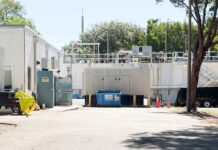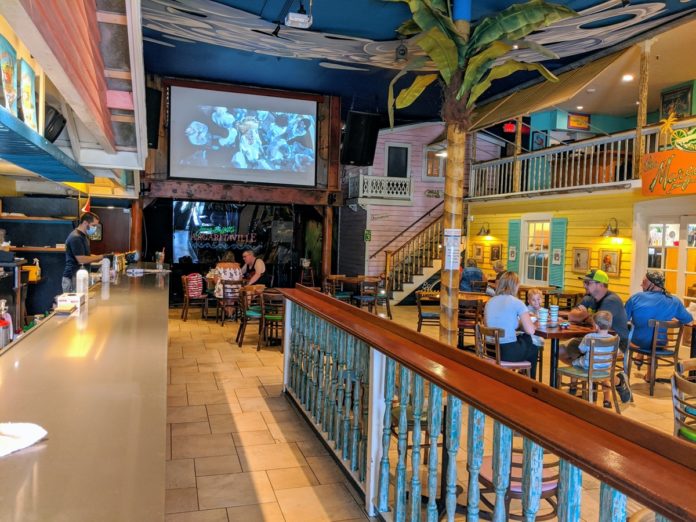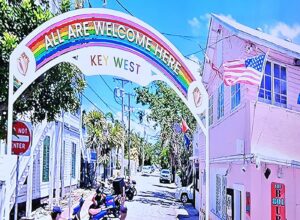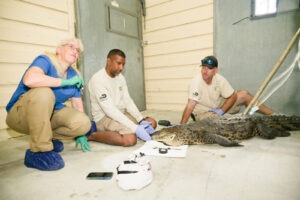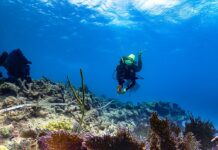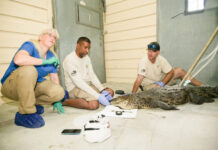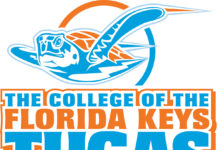Calling it “an act of executive grace,” Florida Gov. Ron DeSantis’ latest order removed fines and penalties levied against those who violated mask ordinances or social distancing guidelines during the coronavirus pandemic.
The order took effect immediately as the governor announced phase 3 of the state’s reopening during a Sept. 25 press conference alongside members of the restaurant industry in St. Petersburg. While the order eliminates the collection of fines for COVID-19-related violations, it didn’t address eliminating the various measures local municipalities enacted, such as the mandatory mask-wearing upon entering businesses and restaurants in Monroe County.
Monroe County’s facial covering ordinance is still in effect and can be enforced against businesses that do not follow Monroe County ordinance 026-2020. There will be no citations against individuals, but code compliance can still cite businesses that are not requiring facial coverings inside the business, said Kristen Livengood, county public information officer.
Signs along U.S. 1 still contain messages of the mask requirement as motorists enter the Keys. And signs remain on business doors to wear a mask upon entry. Those eating at restaurants also must wear a mask until seated.
As for the executive order, DeSantis said it’s time to end penalties against people for social distancing and start working constructively with them.
“Some actually have jail sentences attached. I don’t know if that’s actually been done,” DeSantis said. “All these fines we’re going to hold in abeyance and hope we can move forward in a way that’s more collaborative,” he said.
Bob Eadie, health officer for Monroe County, said individuals need to take responsibility for their own health. Wearing masks is one of the most important measures to help prevent the spread based on guidance from the Centers for Disease Control and Prevention, Eadie said.
“Going forward with where we are, I think everybody should heed that advice,” he said. “The governor was very clear that the pandemic has not gone away. There’s still infections in Florida, but it’s gone down a great deal,” Eadie said.
The Florida Department of Health reported 3,259 new cases and a positivity rate 5.01% as of Sept. 28. In the Keys, the local health department reported eight new cases and three hospitalizations, three at Lower Keys Medical Center and one at Mariners and Fishermen’s hospitals, as of Sept. 29.
With DeSantis’ phase 3 reopening came a flood of calls to the Key Largo Chamber of Commerce from people traveling to the Keys, said president Elizabeth Moscynski.
“There were a lot of people saying ‘we’re not going to come’ and ‘we’re not going to do this.’ One conversation was 45 minutes with someone and another conversation was a half-hour with someone,” she said.
Moscynski said if people are taking precautions, wearing masks and washing hands, “then you’ll be fine.”
DeSantis’ executive order also gave restaurants the ability to operate at a minimum capacity of 50%, regardless of local rules. That means restaurants can go back to full capacity if they choose.
If local municipalities restrict restaurant capacities further than 50%, DeSantis said they must provide justification and costs involved with those actions.
“I think this will be important to the industry in recognition that they have worked as hard as anybody to create safe environments,” DeSantis said. “The idea that government dictating this is better than them (restaurants) making these decisions so customers have confidence, I think, is misplaced.”
Indoor dining in Florida had been closed as the coronavirus pandemic began to unravel in mid-March. By May 4, DeSantis gave restaurants the ability to reopen outdoor seating with tables distanced and dine-in capacity at 25%. By May 18, the governor moved indoor dining to 50% capacity.
Florida remained under a phase 2 reopening since the beginning of June. Some 16 weeks later, DeSantis said everybody has to have an opportunity to work and business to operate. While local governments can enact what DeSantis called “reasonable regulations,” he said, “you can’t just say ‘no’ after six months and have people twisting in the wind.”
In the Keys, restaurants and bars have been able to operate at 50% indoor capacity. Outdoor seating isn’t limited, as long as tables are 6 feet apart.
“Some businesses still prefer to have social distancing. It all depends on where their comfort zone is,” Islamorada Chamber of Commerce executive director Judy Hall said. “I’ve heard from a few restaurants that aren’t ready to put more tables in to go to 100%.”
Simone Mullis operates both Dockside Bar and Grill and Marathon Grill and Ale House, two popular eateries in Marathon. The Ale House has been closed since March, and reopened last week. The restaurants’ social distancing and mask requirements have not changed.
“At the Ale House we are going to operate at 50% capacity. I bought some big plants to put on tables that we won’t use, and added some tables on the sidewalk,” she said of the restaurant located in Gulfside Village.
Dockside Bar and Grill is an open-air restaurant and bar located right on Boot Key Harbor. The outside music venue gives people an added measure of confidence, Mullis said.
“People even dance in their mask,” she said, laughing. Mullis said she has had some pushback from people who don’t like masks, but she keeps the conversations upbeat. “I tell them I love wearing my mask and ‘We gotta do what we gotta do.’”
Marathon Chamber of Commerce CEO Daniel Samess said food and beverage members are “elated they can begin to operate at a capacity they feel comfortable with.”
“They can serve more patrons and maybe make up for some lost revenue,” Samess said. “Most Marathon businesses are optimistic while still wary of another spike or small spike in coronavirus cases.”
County commissioners voted on Sept. 2 to allow restaurants to resume their normal hours of operation and allow a COVID-related 11 p.m. curfew to lapse. The curfew had forced restaurants to close, as well as retail alcohol sales at stores, to end at midnight.
Not all counties have proceeded to phase 3 yet. In South Florida, Miami-Dade and Broward counties just recently entered phase 2.








